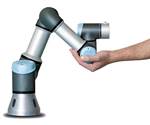Making Standard Robots More “Collaborative”
Laser scanners can slow or stop a robot temporarily when a human approaches.
One of the many themes at October’s K 2016 show in Dusseldorf was getting robots to work more closely—and safely—with humans. On the one hand, suppliers introduced new models of so-called “collaborative” robots, or “cobots,” such as the small tabletop assembly model, dubbed YuMi (pictured), from ABB Automation (U.S. office in Auburn Hills, Mich.). Fanuc Automation (Rochester Hills, Mich.), Kuka Robotics (Shelby Township, Mich.), and Universal Robots (E. Setauket, N.Y.) also showed six-axis cobots.
Meanwhile, suppliers showed how to allow technicians access to robots without shutting them down altogether. Both Sytrama, sister company of Negri Bossi (New Castle, Del.), and Staubli Robotics (U.S. office in Duncan, S.C.) demonstrated robots that use compact laser scanners to sense the presence of humans. When a technician approaches within a certain distance, the robot continues its cycle, but at a much reduced speed, which Staubli calls Safe Limited Speed (SLS). Coming even closer can cause the robot to slow further and finally stop completely (Safe Operating Stop, or SOS). It starts up again instantly when the person moves away a certain distance. Staubli’s new generation of TX2 six-axis robots (pictured) use the same principle to define a Safe Zone around the end-of-arm tooling to prevent collisions with inanimate obstacles. These models also have a sensory skin, which when touched immediately brings the robot to a halt.
Sources at both Sytrama and Staubli agree that even with the laser scanner, some sort of physical barrier is still necessary to prevent accidental encroachments from hindering robot operations, but full-height guarding may no longer be needed with this safety feature. One maker of the laser scanners is in Germany (U.S. office in Minneapolis). It is the yellow object at the bottom of the photo with the Staubli robot.
Related Content
-
Boston Dynamics Stretches Into Autonomous Warehouse Robotics
The robotics company’s second commercial product is designed to take on physically challenging warehouse tasks.
-
Ensuring Repeatability: The Key to Effective Injection Molding Automation
One of automation’s key promises is repeatability: the same movement to the same location, time and time again. But to achieve that, all elements involved — robot, machine, EOAT, mold — must be in and stay in alignment.
-
'Smart,' Moisture-Based Drying Technology Enhanced
At NPE2024, Novatec relaunches DryerGenie with a goal to putting an end to drying based on time.


